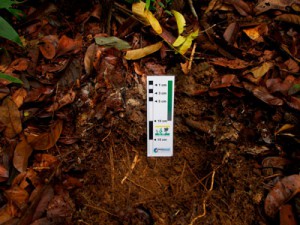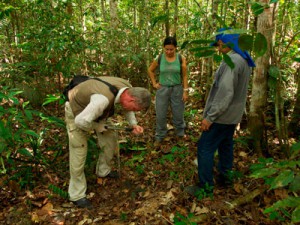Methods
Soil samples have been taken successfully at all sites. To check reproducibility, repetitions were done in project phases 2 and 3. Mineral soil samples were taken with Sondaterra soil augers (ø 10 cm) after removing the litter layer carefully with lab glove-protected hands.
 Step 1: Organic debris (litter = ORG) was sampled manually, representative for the entire site (ca. 1 hectare). Larger living plants, stones and larger roots were removed. The potentially most organic-rich material was transferred into cotton bags to support rapid air drying.
Step 1: Organic debris (litter = ORG) was sampled manually, representative for the entire site (ca. 1 hectare). Larger living plants, stones and larger roots were removed. The potentially most organic-rich material was transferred into cotton bags to support rapid air drying. Step 2: The first approximately 20 cm of mineral soil (TOP) were drilled with pre-cleaned Sondaterra soil augers. Pre-cleaning was done by drilling in direct proximity to the final drill hole down to the desired depth, discarding that sample and manually cleaning the auger before taking the “real” sample. Smaller visible stones or larger roots were discarded. The remaining mineral soil material was filled into pre-coded RILSAN® sampling bags, marked with waterproof markers. Bags were closed tightly with the provided strips and remained closed until return to the laboratories.
Step 2: The first approximately 20 cm of mineral soil (TOP) were drilled with pre-cleaned Sondaterra soil augers. Pre-cleaning was done by drilling in direct proximity to the final drill hole down to the desired depth, discarding that sample and manually cleaning the auger before taking the “real” sample. Smaller visible stones or larger roots were discarded. The remaining mineral soil material was filled into pre-coded RILSAN® sampling bags, marked with waterproof markers. Bags were closed tightly with the provided strips and remained closed until return to the laboratories.- Step 3: Drilling to 30 cm depth. This material was discarded (used to fill the hole after drilling down to 50 cm).
- Step 4: Each sampling hole was “overdrilled” to the final depth of about 50 cm (BOT sample). The next steps followed the same procedure as in step 2.
- Step 5: After retrieving the last sample from each of the sub-sites, each site was “groomed”, filling excess material into the holes and camouflaging the sub-site with organic litter material to prevent accidents and to leave a “clean” spot. This last step does not serve beauty, but follows the codex: “Take only memories, leave only footsteps” – and makes for good friends with the site owner.
- Step 6: Following each of the sampling steps, the RILSAN® bags were transported into a vehicle, double bagged (second RILSAN® bag with full sample description) and carefully stored. All bags were checked for tight closure and very tight fit within the vehicle to reduce rubbing and possible damage.
Results
All ORG, TOP and BOT material from phases 01 to 03 have been analyzed for total C, N, S and TOP and BOT for organic carbon (elemental analysis), for all other major (WD-XRF and ICP-OES), minor and most trace elements (WD-XRF, ICP-OES, ICP-QMS). Values below are median values.
- ORG material: Total carbon (TC) in forest soil 41.6 wt.%, post-forest soil 42.4 wt.%. Organic carbon (TOC, only from phase 01) 37.2 wt.% in forest soil, 39.0 wt.% in post-forest soil. Total nitrogen (TN) in forest soil 1.58 wt.%, 1.31 wt.% in post-forest soil. C/N ratios in forest soil litter 24, in post-forest litter 30. Total sulphur (TS) in forest material 0.173 wt.%, in post-forest litter 0.167 wt.%.
- TOP samples: Forest soil TC 2.17 wt.%, in post-forest areas 1.80 wt.%, showing relative carbon loss within years to decades. TOC in forest soil 1.73 wt.-%, in post-forest soil 1.38 wt.%. TN in forest soil 0.165 wt.%, in post-forest soil 0.137 wt.%; again loss over time. TS was identical in forest and post-forest soil (0.027 wt.%).
- BOT samples: Forest soil TC 1.03 wt.%, in post-forest soil 0.94 wt.%. TOC in forest and post-forest soil 0.78 wt.%. TN 0.089 wt.% in forest soil, 0.085 wt.-% in post-forest soil. TS was identical in forest and post-forest soil (0.021 wt.%). Obviously all three macro-nutrients are depleted in lower soil levels.
The most surprising preliminary result are comparatively high concentrations of carbon and nitrogen – considerably higher as compared to northeastern Brazil – and equal to median values of Europe.
Soil pH TOP: No surprises: forest soils show lower pH-values (pH H2O: 4.0 to 4.7 and pH CaCl2: 3.8 to 3.9), post-forest soil (pH H2O: 4.5 to 5.2, pH CaCl2: 4.0 to 4.1). This agrees with previous studies and confirms the slightly unfavourable degassing boundary conditions, since acidic conditions suppress soil respiration. The formation of humid and fulvic acids under forest canopy lowers the pH-values, while no such effect exists in the post-forest land-cover environments.
Soil pH BOT: Forest soil pH H2O: 4.2 to 4.6, post-forest 4.2 to 4.9. pH CaCl2 under forest (3.9 to 4.1) and post-forest 3.9 to 4,0). While slightly different from the higher soil level this is not a major shift.
Major, minor and trace elements
In total 65 elements with all major and minor and most trace elements were fully quantified. Significant differences occur in comparison with older publication from the region. A first manuscript is almost ready to be handed in for review.